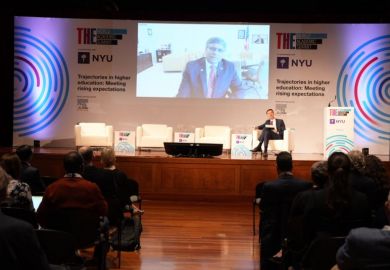Federally funded academic research is gaining potential as a US election campaign issue, with Washington making a new bipartisan push to expand its distribution of scientific dollars to regions of the country that win very little on their own.
Leading examples include the new “regional innovation” projects run by the National Science Foundation and the Department of Commerce, on top of new funding for the NSF’s longstanding Epscor programme for routeing grant money to less competitive states.
Such ideas have found allies in both major political parties, as lawmakers facing re-election seek ways to prove to voters their ability to extract dollars from Washington. That support, however, is concentrated in conservative-leaning states, mostly in the central part of the US, with lower-ranked universities.
That’s left the NSF in the position of promoting geographic-based favouritism, while trying to reiterate that political imperatives will be balanced with the agency’s science-based mission.
“State boundaries are an important consideration, but not the only one,” in budget allocations, an NSF spokesperson said. The agency has made clear that “economic conditions and investment levels can vary widely by community and that the entire picture must be considered when making award decisions”, the spokesperson said.
Academic research certainly has its own political stakes in the 2024 elections. President Joe Biden has regularly expressed a trust in scientific expertise, as a contrast to his likely Republican challenger, Donald Trump. Mr Trump has promised new rules that would more easily let him oust governmental scientists, among other non-partisan federal employees, while Mr Biden has been seeking ways to prevent that possibility and toughen the government’s overall rules for ensuring scientific integrity.
Epscor is a familiar part of NSF, created in 1979 and replicated since then at other federal funding agencies. The regional initiatives at NSF and Commerce arose from the $280 billion (£220 billion) Chips and Science Act, a 2022 law that also called for the 28 Epscor states to be getting 20 per cent of NSF research funding by 2029. Those 28 states currently get about 13 per cent of NSF grant awards, while New York and California together receive about twice as much.
The NSF’s Regional Innovation Engines and the commerce department’s Regional Technology and Innovation Hubs are also heavily concentrated in the less-populated middle of the US. They consist of locations that will be given awards in the range of $30 million to $70 million to develop research and commercial expertise in a list of fields that include quantum computing, alternative energy and storage, polymers, semiconductors and various types of advanced manufacturing and sustainable materials.
The wisdom of growing Epscor and its many derivations has long been disputed, as the fundamental idea means taking money from states and universities that have proven themselves to be most deserving through respected merit-based scientific evaluation processes.
Various studies of Epscor over the decades have struggled to demonstrate clear value in terms of making the beneficiary universities competitive on their own. Analyses have suggested, though, that the regional set-asides can help identify and nurture talented scientists who might otherwise get overlooked.
Register to continue
Why register?
- Registration is free and only takes a moment
- Once registered, you can read 3 articles a month
- Sign up for our newsletter
Subscribe
Or subscribe for unlimited access to:
- Unlimited access to news, views, insights & reviews
- Digital editions
- Digital access to THE’s university and college rankings analysis
Already registered or a current subscriber?








